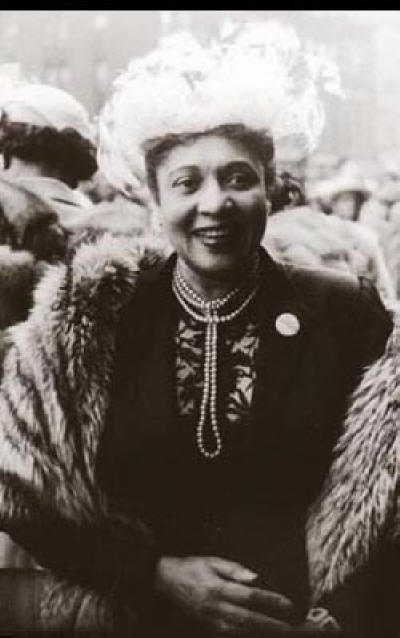

Partner Elizabeth Byrd
Queer Places:
W 135th St & 5th Ave, New York, NY 10037
 Gerri
Major (July 29, 1894 – August 17, 1984) was an African-American woman who
lived in Harlem during a career that stretched from the 1920s through the
1970s. She was successful in a number of overlapping vocations including
journalist, editor, newscaster, publicist, public health official, author, and
community leader. An article celebrating her 80th birthday said "Gerri was
definitely one of the 'new Negroes' of the early 20th Century" adding that by
the end of the 1930s she had become "one of the best known black women in
America."[4]
At the end of her life she lived with her companion,
Elizabeth Byrd.
Gerri
Major (July 29, 1894 – August 17, 1984) was an African-American woman who
lived in Harlem during a career that stretched from the 1920s through the
1970s. She was successful in a number of overlapping vocations including
journalist, editor, newscaster, publicist, public health official, author, and
community leader. An article celebrating her 80th birthday said "Gerri was
definitely one of the 'new Negroes' of the early 20th Century" adding that by
the end of the 1930s she had become "one of the best known black women in
America."[4]
At the end of her life she lived with her companion,
Elizabeth Byrd.
Major was born on July 29, 1894 in her parents' home on Wentworth Avenue at the western border of the Douglas section of Chicago's Bronzeville neighborhood.[4] Her father was Herbert Hodges and her mother was Mae Powell Hodges.[2] Major reported that her mother's grandfather had migrated from North Carolina to Indiana seeking freedom.[49] Soon after her mother died while giving birth to her, she was adopted by her mother's sister, Maud Lawrence, and her husband David.[6] The Lawrence family had sufficient wealth to give Major an extravagant debutante ball.[6] While yet unmarried, Major kept Hodges as her family name.[6][7]:91
On December 15, 1917, Major married H. Binga Dismond in a military ceremony at Camp Logan in Houston.[2][6] They were divorced in 1933 but remained cordial.[12][32][67] In 1942 she married musician Gilbert Holland, a baritone whose voice was heard frequently on radio programs of the 1930s.[12][68][note 24] Her last marriage was to a prominent mortician from Atlantic City, New Jersey, John Richard Major. The ceremony took place in Buenos Aires during a trip they took to South America, probably in 1946.[4] This was her third marriage and his fourth.[70] She was widowed by 1953 and did not remarry during the remaining three decades of her life.[4]
During World War I she was a major in the American Red Cross. Thereafter she became a society columnist and editor for African American newspapers in her home city of New York as well as Pittsburgh, Chicago, and Baltimore. In 1936 a newspaper reporter said her talent for writing vivid prose, her editing skill, and her ability to maintain a wide circle of influential friends brought her fame and gave her "a unique position similar to that of an arbiter over the local social set."[5] At the time of her death she held joint positions as associate editor of Jet and senior staff editor of Ebony magazine.
During all of her adult life she was an active participant in civic organizations that worked to improve the health, education, and general well-being of New York's African American community, and for ten years from 1936 to 1946 was a publicity specialist for the Central Harlem Health District.
A familiar and visible figure in the Harlem Renaissance, gossip columnist
Geraldyn Dismond reported on the Harlem social scene in The Inter-State
Tattler, The Amsterdam News, The Pittsburgh Courier, and other
African-American papers. She spent several years as managing editor of the
Tattler, a New York City newspaper that gave accounts of African-American
high society in Harlem, Chicago, and other cities.
Known to many as
“Gerry Major,” Dismond graduated from the University of Chicago, married a
doctor, and worked briefly as a teacher. During World War I, she was a major
in the Red Cross. Eventually, Dismond left her husband, moved from Chicago to
Harlem, and found her “true vocation, . . . delineating the social scene in a
series of columns.”
Dismond was a regular at
A’Lelia Walker’s salon, known as
The Dark Tower, and her accounts of the comings and goings of Harlem’s
artistic and intellectual set at these affairs were read widely. Glamorous and
lovely, Dismond held many parties of her own and was sometimes referred to as
“Harlem’s Hostess.” In 1928, Geraldyn Dismond opened the Geraldyn Dismond
Bureau of Specialized Publicity, on 135th Street. She gave herself the title
“Publicity Agent.”
In addition to her society journalism and work as a
publicity specialist, Dismond was also a radio announcer. She became the first
African-American woman to host a regular show. Her program, “The Negro
Achievement Hour,” aired first on WABC and later appeared on other area
stations.
My published books: